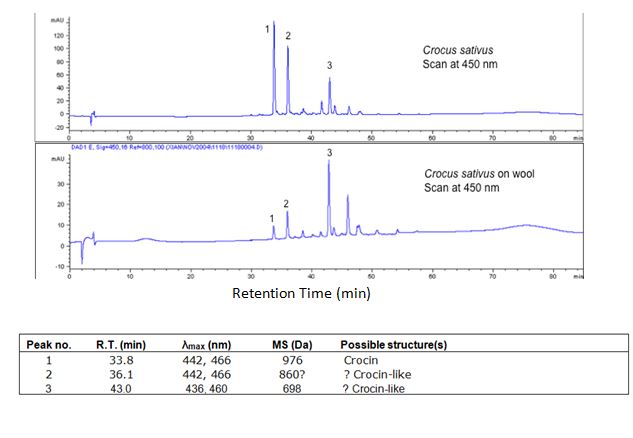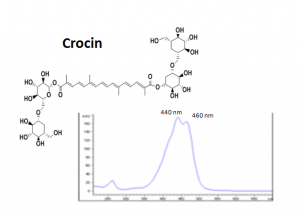Difference between revisions of "Saffron (Crocus sativus) LC"
| (3 intermediate revisions by the same user not shown) | |||
| Line 2: | Line 2: | ||
== Description == | == Description == | ||
| + | The saffron crocus is a mall, stemless perennial herb. It was naturalized perhaps from the wild crocus in the Mediterranean area. Now it is grows in temperate and subtropical areas in Europe and Asia. | ||
| + | The dried flower stigmas was used. | ||
== Historical importance == | == Historical importance == | ||
| Line 9: | Line 11: | ||
== Summary of results == | == Summary of results == | ||
| − | + | Saffron is a direct dye. The main dyeing components are carotenoids: crocetin and crocetin esters. They are grouped as CI75100, Natural Yellow 6. | |
== Analytical instrumentation and procedures == | == Analytical instrumentation and procedures == | ||
| + | HPLC-DAD-MS analysis was performed with an Agilent 1100 liquid chromatography system consisting of an automatic injector, a gradient pump, a HP series 1100 DAD, and an Agilent series 1100 VL on-line atmospheric pressure ionization electrospray ionization mass spectrometer. Separations were done on a Vydac 214TP52 analytical column (2.1 mm diameterX250 mm; 5-ím particle size). The column was eluted at a flow rate of 0.2 mL/min with a tertiary gradient of water (A),acetonitrile (B), and 1% (v/v) aqueous formic acid (C) with the following elution program: 0 min, 90% A, 5% B, 5% C; 0-55 min, a linear gradient to 35% A, 60% B, 5% C; 55-60 min, a linear gradient elution to 15% A, 80% B, 5% C; 60-62 min, isocratic elution at 15% A, 80% B, 5% C; 62-70 min gradient elution to 90% A, 5% B, 5% C; and reequilibration with the latter solvent for 15 min. The mass spectrometer was run both in the negative and positive ion mode. | ||
== Chromatograms == | == Chromatograms == | ||
Latest revision as of 10:22, 29 September 2017
[[File:|thumb|Yellow Botanic Gardens]]
Description
The saffron crocus is a mall, stemless perennial herb. It was naturalized perhaps from the wild crocus in the Mediterranean area. Now it is grows in temperate and subtropical areas in Europe and Asia.
The dried flower stigmas was used.
Historical importance
Summary of results
Saffron is a direct dye. The main dyeing components are carotenoids: crocetin and crocetin esters. They are grouped as CI75100, Natural Yellow 6.
Analytical instrumentation and procedures
HPLC-DAD-MS analysis was performed with an Agilent 1100 liquid chromatography system consisting of an automatic injector, a gradient pump, a HP series 1100 DAD, and an Agilent series 1100 VL on-line atmospheric pressure ionization electrospray ionization mass spectrometer. Separations were done on a Vydac 214TP52 analytical column (2.1 mm diameterX250 mm; 5-ím particle size). The column was eluted at a flow rate of 0.2 mL/min with a tertiary gradient of water (A),acetonitrile (B), and 1% (v/v) aqueous formic acid (C) with the following elution program: 0 min, 90% A, 5% B, 5% C; 0-55 min, a linear gradient to 35% A, 60% B, 5% C; 55-60 min, a linear gradient elution to 15% A, 80% B, 5% C; 60-62 min, isocratic elution at 15% A, 80% B, 5% C; 62-70 min gradient elution to 90% A, 5% B, 5% C; and reequilibration with the latter solvent for 15 min. The mass spectrometer was run both in the negative and positive ion mode.
Chromatograms
Sample information
Identified compounds
| Compound | RT (min.) | MW | UV/vis | Other |
|---|---|---|---|---|
| crocin | 33.8 | xx | xx | Comments here |
| x | x | x | x | |
| x | x | x | x | |
| x | x | x | x |
References
[1] [2] [3]


